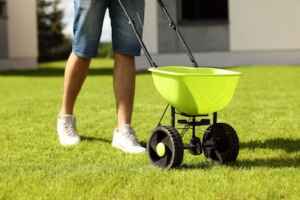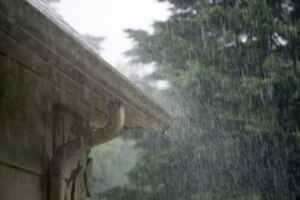Using Fertilizer On Wet Grass
Applying fertilizer to your lawn can help it flourish and grow. But, knowing the right time to apply it can be tricky. Is it better when it is wet outside? Do you know how many bags you need for your lawn size?
So, can I apply fertilizer to wet grass? One of the best times to fertilize your lawn is right after a good rainstorm. Rain helps dissolve fertilizer into the soil and this will help fertilizer reach its target throughout grassroots.
Adding fertilizer after rainfall also allows more time before you water again. This gives fertilizer time needed for uptake into plant tissue through foliage or root growth (fertilizer takes about 2 to 4 days to work).
Fertilizer can be a beneficial part of lawn care as long as it is used properly. Read on to find out the answers to all your fertilizer questions.
When is the Best Time to Fertilize My Lawn?
Lawn fertilizer can be applied at any time during the growing season. The most important factor is that you water your lawn well after fertilizer application. If fertilizer isn’t watered in, it can cause fertilizer burn and also increase weed growth.
How Much Fertilizer Should I Apply?
Follow the fertilizer label instructions for the amount of fertilizer you will need. Fertilizer recommendations are usually based on lawn size.
Look for a fertilizer with slow-release nitrogen sources for optimal plant growth, because slow-release means less chance of fertilizer burn.
If you are not sure of the amount of bags you may need, your local home and garden store will be able to help you too. You will be able to differentiate between types of fertilizers, and the amount that will be enough for your lawn size.
Also, you could look into the best way to water your lawn in accordance with how you fertilize it.
How Long After Rain Should I Apply Fertilizer?
Ideally, it’s best to wait two or three days after a good rain before fertilizing your lawn. This will help the fertilizer absorb into the soil rather than runoff.
However, if it has been several days since rainfall and your lawn is looking thirsty, go ahead and water first before applying fertilizer. You have options when it comes to placing fertilizer. This allows you to not have to wait on rain or a dryer day to take care of your lawn.

What Kind of Fertilizer Should I Use on Wet Grass?
When fertilizer is mixed with water, it creates a slurry or soup that can easily be washed away. Because fertilizer will run off more easily on a wet surface, using a fertilizer that has slow-release or controlled-release nutrients is ideal.
This type of fertilizer will help to keep your lawn fed for an extended time. The longer your lawn is fed, the less you have to reapply, this saves you time and money.
Is Fertilizing My Lawn When it Rains Beneficial?
Fertilizing your lawn when it rains can be very beneficial. As mentioned before, rain helps dissolve fertilizer and get it down into the soil where it is needed. Additionally, rainfall helps to activate fertilizer and speed up the process of getting the nutrients down to the roots of the grass.
Try to plan accordingly so that you are not out in the rain when it comes time to apply the fertilizer. You will be drenched, and your supplies will be harder to handle.
Should Fertilizer Be Used Before or After Watering?
Fertilizer is most effective when applied directly before rainfall. This will help dissolve fertilizer and wash it down into the soil where grassroots are located.
However, if there has been no rainfall in several days, you may want to water first before applying fertilizer (if possible). Consider turning on the sprinkler in sections. This will allow the water some time to soak the lawn and be prepared to absorb the fertilizer.
Using a fertilizer that has slow-release or controlled-release nutrients is ideal when fertilizing on a wet surface. Follow these steps and your yard should look beautiful!
Hire a Lawn Care Service
When you are not sure when fertilizer should be applied, or how much fertilizer is needed for your lawn, it is a good idea to hire a lawn care service. A landscaping company can provide you with fertilizer throughout the year. If your lawn is suffering from poor grass or weeds, ask for their help in treating the problem.
You will be surprised at how much fertilizer can improve your lawn, and at the same time, you will know that you are hiring a professional with the right tools for the job.
Synthetic vs. Organic Fertilizer
You may have heard that fertilizer can be detrimental to your grass if applied when the ground is wet. This may be true for some fertilizer types, but not all fertilizer types. Whether or not a fertilizer can damage your grass depends on what kind of fertilizer was used and how it was applied.
Fertilizers can either be organic or synthetic. Organic fertilizer is made of materials that come from plants or animals, while synthetic fertilizer is made of inorganic materials.
There can be a price difference between these two types of fertilizers, but pay close attention to the type that will be more beneficial for your lawn.
Synthetic
Most synthetic (not organic fertilizers) contain soluble nitrogen compounds such as urea-formaldehyde and ammonium sulfate.
If contact with water occurs after these compounds are dissolved in water, they will immediately react with one another which could potentially cause the ‘burning’ of your lawn.
Organic
Organic fertilizers, on the other hand, tend not to pose this threat. Organic fertilizers usually contain a high percentage of slow-release nitrogen which is released gradually as the fertilizer decomposes. This gradual release is less likely to cause any damage to your grass.
When choosing a fertilizer for your lawn, make sure to select one that is specifically meant for use on wet grass. This type of fertilizer will contain more nitrogen than other fertilizers and will help your lawn to recover more quickly from rain damage.
Steps to Take When Fertilizing Your Lawn
Fertilizing your lawn when it rains may seem like an unnecessary step, but it can be quite beneficial. By fertilizing your lawn after a rainstorm, you’re helping to restore the nutrients that were lost due to the rain. Additionally, fertilizer can help to prevent future rain damage by strengthening your lawn’s root system.
While fertilizer can be used when the grass is wet, it’s important to avoid over-fertilizing. This can damage your lawn. If you’re not sure how much fertilizer to use, consult with a professional or refer to the fertilizer’s packaging.
Fertilizer should be applied with water to your lawn to ensure that fertilizer is properly absorbed. You can also use fertilizer after watering your lawn. However, if you do so, be sure to water it again so that fertilizer doesn’t remain on top of the grass where it can cause damage.

Expected Rain Forecast
Fertilizing your lawn when it rains may not be necessary, but it will help to boost the health of your lawn. If rain is forecast within 48 hours, you can apply fertilizer up to 48 hours before rain is predicted.
If fertilizer isn’t available for use with wet grass, try using fertilizer meant for dry grass or wait until after watering to fertilize.
If you are interested in restoring nutrients lost due to rain damage, pick a fertilizer specifically meant for wet grass rather than one meant for dry grass.
If fertilizer is used when it is not raining, be sure to water the fertilizer into the ground. To protect your lawn from future damage, fertilize after a rainstorm to strengthen your grass’ root system and prevent future problems.
The bottom line is: that as long as you follow the instructions on the fertilizer product label, you should be fine. As always, make sure to read before applying anything!

Timing is Everything
If you are unsure whether or not to apply fertilizer to an area that has just rained, it’s always a good idea to contact the manufacturer of the fertilizer product for clarification. They will be able to tell you whether or not it is safe to apply in wet conditions and how much water is needed for activation.
Depending on the time of year, it would be best to keep a schedule of when you apply fertilizer. When it is hotter, the grass tends to be drier and needs more water. But, as it gets colder, the need for water lessens. Make sure to adjust your fertilizer schedule as the seasons change to keep your grass as healthy as possible.
In most cases, waiting until the ground has dried out before applying fertilizer is unnecessary and could lead to a delay in achieving your desired results. Applying fertilizer to wet grass won’t necessarily harm your lawn, but it’s always important to read the product label and follow the instructions carefully.
Fertilizing your lawn is a great way to promote healthy growth and keep your grass looking green and lush all season long!

